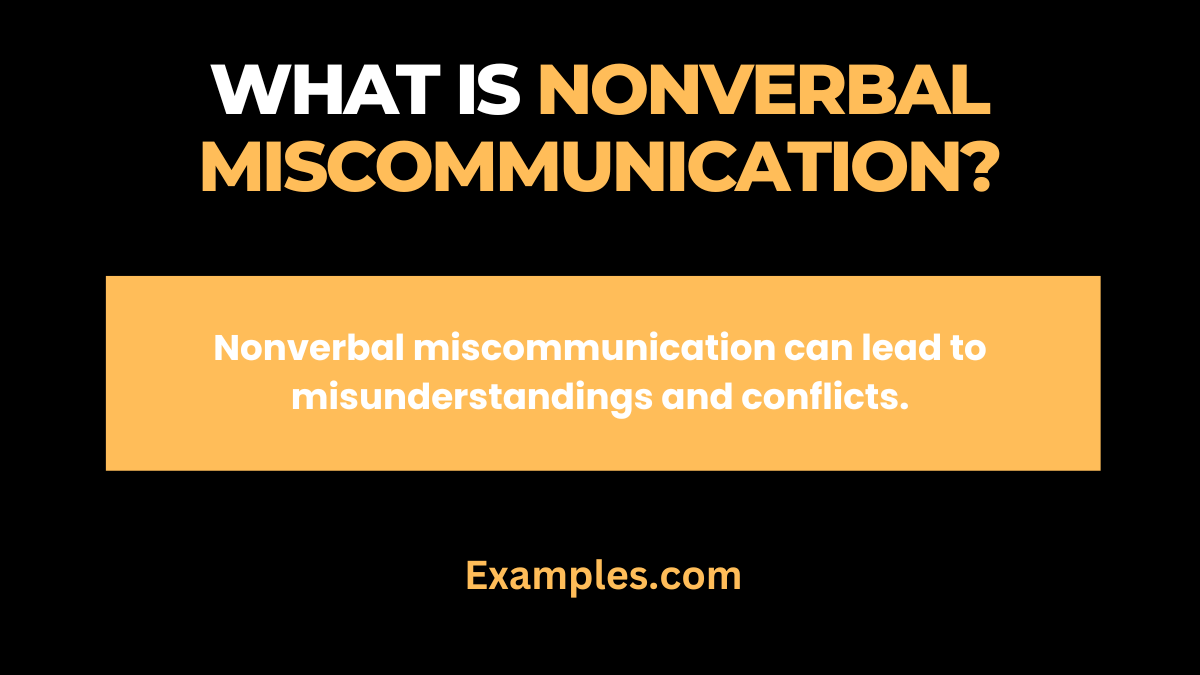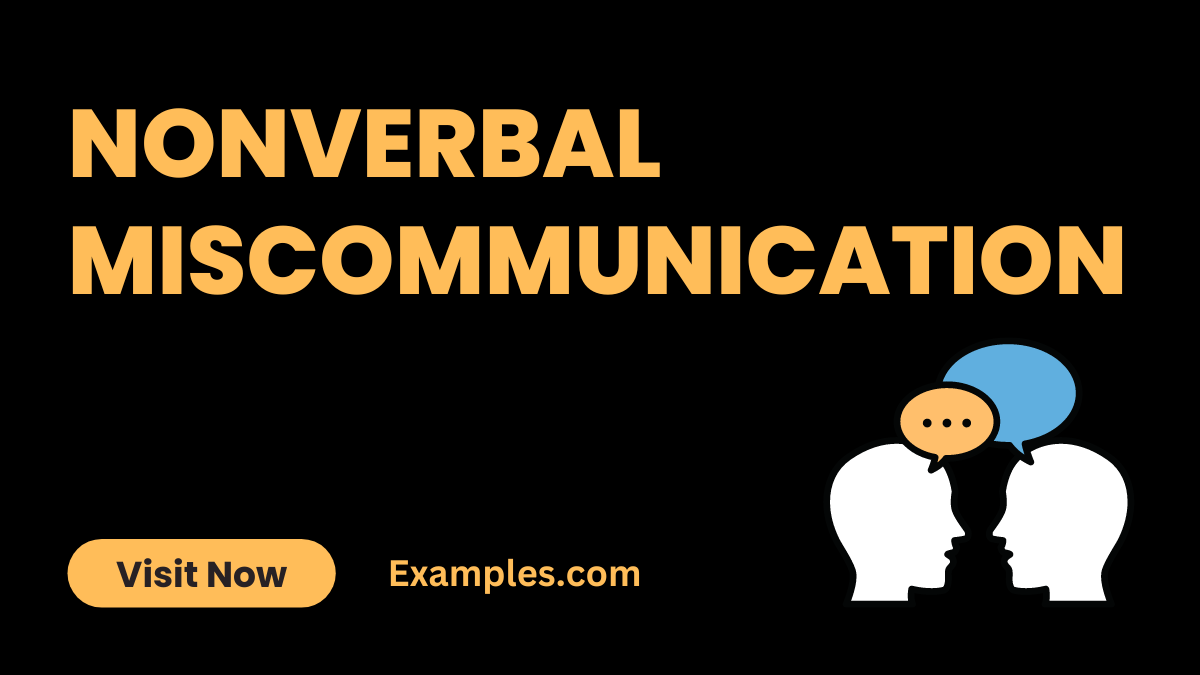19+ Nonverbal Miscommunication Examples
Nonverbal communication plays a pivotal role in how we convey and interpret messages. Often, nonverbal cues can lead to miscommunication examples, causing confusion and misunderstandings. This guide delves into the subtle world of nonverbal signals, exploring how body language, facial expressions, and gestures can be misinterpreted. By understanding these nuances, we can enhance our communication skills and avoid common pitfalls in conveying our intended messages.
What is Nonverbal Miscommunication?

Nonverbal miscommunication occurs when body language, facial expressions, or gestures convey a message that is misunderstood or misinterpreted by others. It’s a significant aspect of communication, often overshadowing verbal communication. Understanding nonverbal cues is crucial as they can convey emotions and intentions differently than spoken words. In various settings, from personal interactions to professional environments, nonverbal miscommunication can lead to confusion, misunderstandings, and even conflicts.
20 Nonverbal Miscommunication Examples

- Crossed Arms: Often interpreted as defensiveness or disinterest. To communicate openness, try keeping your arms relaxed at your sides.
- Avoiding Eye Contact: Can signal dishonesty or discomfort. Maintain moderate eye contact to show engagement.
- Excessive Nodding: Might be seen as over-agreement or not taking the conversation seriously. Nod minimally to show understanding.
- Tapping Feet: Can indicate impatience or nervousness. Keep feet still to appear more composed.
- Frowning: May be read as disapproval or unhappiness. A neutral facial expression is more approachable.
- Thumbs Up: In some cultures, this is offensive. Use verbal affirmations instead.
- Yawning: Can be perceived as boredom. Cover your mouth and excuse yourself if necessary.
- Rolling Eyes: Seen as disrespectful. Maintain a steady gaze to show respect.
- Standing Too Close: Can make others uncomfortable. Respect personal space for comfortable interactions.
- Finger Pointing: Often viewed as aggressive. Use open hand gestures to be more welcoming.
- Slouched Posture: May indicate lack of confidence or interest. Stand or sit up straight to show attentiveness.
- Rapid Blinking: Can suggest disbelief or stress. Try to blink normally to appear calm.
- Shrugging Shoulders: Might imply indifference. Verbalize your thoughts for clarity.
- Drumming Fingers: Suggests impatience. Rest hands on a table or in your lap.
- Smirking: Can be misinterpreted as sarcasm. Smile genuinely to convey friendliness.
- Whispering to Others: Appears secretive or rude. Speak openly to include everyone.
- Hand Over Mouth: Can signal dishonesty. Keep hands away from your face while speaking.
- Pacing: Might indicate anxiety. Stand or sit still to appear more at ease.
- Checking Watch Frequently: Seems like you’re uninterested. Check time discreetly if necessary.
- Lack of Smiling: May be seen as unfriendliness. Smile appropriately to seem approachable.
Nonverbal Miscommunication in the Workplace
- Misreading of Facial Expressions: Misinterpreting a colleague’s facial expression can lead to assumptions about their thoughts or feelings, affecting team dynamics.
- Body Language in Meetings: Unintentional body signals like slouching or not facing speakers can be seen as disinterest or disrespect.
- Gestures in Presentations: Overly dramatic or minimal hand movements can distract or confuse the audience about the presenter’s confidence and clarity.
- Physical Proximity During Conversations: Not respecting personal space can make colleagues feel uncomfortable and affect professional relationships.
- Nonverbal Cues in Negotiations: Failure to recognize and interpret body language can lead to missed cues and opportunities in business negotiations.
- Virtual Meeting Challenges: Lack of nonverbal cues in remote meetings can lead to misinterpretation of intentions and messages.
- Cultural Differences in Nonverbal Communication: Ignoring cultural variances in gestures and expressions can cause misunderstandings in diverse workplaces.
- Email Tone Misinterpretation: Absence of nonverbal cues in emails can lead to misconstrued tone or intent, affecting professional communication.
- Workplace Gossip and Body Language: Relying on nonverbal cues for workplace gossip can spread false information and create a toxic environment.
- Dress Code and Professionalism: Inappropriate attire can send unintended messages about an individual’s professionalism or attitude towards their role.
How to Avoid Nonverbal Miscommunication?
- Awareness of Personal Habits: Being conscious of your own nonverbal signals can help in projecting the intended message more accurately.
- Cultural Sensitivity: Understanding and respecting cultural differences in body language enhances effective communication in diverse settings.
- Consistent Verbal and Nonverbal Messages: Aligning your words with your body language ensures clarity and reduces chances of miscommunication.
- Observing Others’ Reactions: Paying attention to how others respond to your nonverbal cues can provide insights into how you’re being perceived.
- Seeking Clarification: When in doubt, asking for clarification can prevent misunderstandings stemming from nonverbal communication.
- Regular Feedback in Teams: Encouraging open feedback about communication styles helps identify and address nonverbal miscommunication issues.
- Training and Workshops: Participating in professional development focused on nonverbal communication skills can be beneficial.
- Mindful Email Communication: Choosing words carefully and using tone indicators like emojis can help convey the right sentiment in written communication.
- Balanced Use of Technology: Leveraging video calls can aid in providing visual cues that are missing in phone calls or emails.
- Self-Reflection and Adjustment: Regularly reflecting on and adjusting your nonverbal communication can greatly improve your interpersonal interactions.
Nonverbal miscommunication is a common yet often overlooked aspect of daily interactions. Recognizing and understanding these nonverbal cues are vital in ensuring effective communication. By being aware of our body language and adjusting it accordingly, we can greatly reduce misunderstandings and build stronger, clearer communication in all areas of life. For effective communication, it’s important to align nonverbal cues with spoken words, thereby enhancing overall interaction quality.



